The project of electrothermochemical gun 60 mm Rapid Fire ET Gun (USA)
In the early nineties, American specialists built and tested an electrothermochemical gun, which could later be used on warships. The project was developed by order of the US Navy and in the future could lead to the rearmament of their ships. It was assumed that in the future such weapons will be used to perform various tasks. This required to ensure the possibility of using guns against surface and shore targets. In addition, it was proposed to increase the rate of guns, which would allow the use of these weapons and for the implementation of air defense.
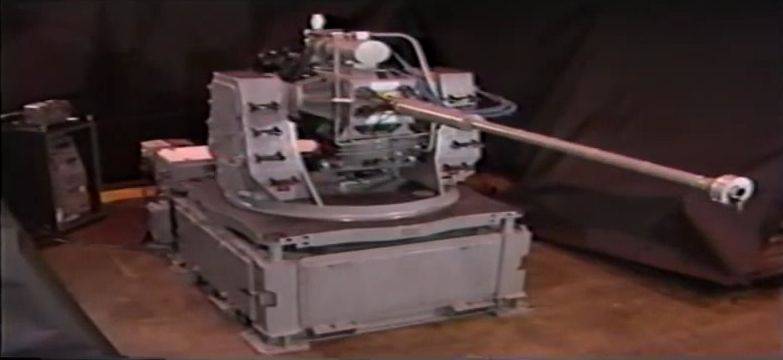
General view of the 60 mm Rapid Fire ET Gun on the ship installation
Electrothermochemical technology (ETH or ETC from Electrothermal-chemical) was created a few decades ago and is intended to improve the performance of barreled weapons, primarily artillery. Weapons built on this technology are generally similar to traditional barreled weapons, but have some differences. The main thing is the principle of the formation of gases for throwing projectile. In the ETH arms it is proposed to use not traditional gunpowder, but new special compositions. In addition, instead of the usual primer-igniter, the projectile must be equipped with a special igniting device, with the help of which the maximum energy output is achieved. Some projects of such systems even offered devices that produce plasma. Due to the latter, it was proposed to increase the energy return during the combustion of the propellant charge.
All existing experimental ETC guns had a similar principle of operation. In general design, they almost did not differ from the "traditional" guns. At the same time they were equipped with an electric propellant ignition system and had to use original projectiles with a cap of a new design. New ammunition and special equipment led to the complication of the design of the gun, however, allowed to increase the flexibility of its use.
One of the main advantages of electrothermochemical guns is the ability to change the muzzle energy by adjusting the parameters of the electric pulse, which is responsible for igniting the propellant charge. Thus, the electric part of the gun provides control of the main parameters affecting the characteristics of the fire. As a result, the operator of the complex gets the opportunity to use the most suitable for the current situation, the mode of operation of the instrument. In practical use, this allows you to change the firing range while maintaining the required kinetic energy and more effectively hit these targets.
Draft ETH gun, developed by order of the US Navy, has not received a full designation. He stayed in stories called 60 mm Rapid Fire ET (or ETC) Gun - "60-mm rapid-fire ETX-gun". Apparently, the absence of a different name or index was due to the experimental nature of the project. The usual alphanumeric index could appear in the case of receiving an order for the development of full-fledged weapons for ships and the successful completion of such a project.
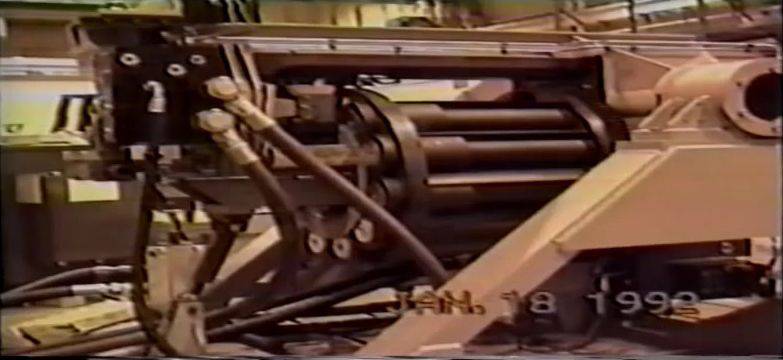
The breech of the gun. Drum for shells clearly visible
Despite this, it is known about the development of an artillery installation on which a promising weapon could be mounted. This system consisted of a deck of boxes, in which a part of special equipment was located, and a movable gun carriage with the possibility of pointing the gun in two planes. The mobile part of the installation had a design traditional for such systems. Directly above the deck there was a cylindrical swivel base on which two vertical posts were mounted with mounts for the rocking artillery unit. This design provided guidance in any direction along the azimuth and within a certain sector of the vertical plane.
Of greatest interest in the 60 mm Rapid Fire ET Gun project is the gun itself, in the design of which several interesting ideas were used. First of all, interesting layout of the gun. It had a 60 mm caliber barrel about 14 feet long (about 4,25 meters), equipped with a characteristic round muzzle brake. In the breech breech there was no traditional chamber, because the gun was built on a revolving scheme. Behind the barrel was a drum with cylindrical chambers for ammunition. A similar scheme was used in view of the need to increase the rate of fire of the weapon. Other layout options, apparently, could not provide the required rate of fire.
The barrel was fixed in a rectangular restraint, in the back of which a horizontal beam was provided with fastenings for an equipment unit responsible for the ignition of the propellant charge. In addition, these two devices were connected to the axis of the drum for the shells. The design of the gun had a separate mechanism for turning the drum. The authors of the project decided to abandon the use of the energy of powder gases or recoil, because of what it took to use a special mechanism, the task of which was to turn the drum before each shot. The rotation of the drum and some other operations were carried out by hydraulic drives, which to some extent could complicate the operation of the implement.
The prototype gun had a drum on 10 shots. The drum consisted of two bearing discs with holes in which the tubular chambers were fixed. The rear disc drum is in contact with the rotation mechanism. According to the available data, an obturation system was provided to exclude pressure losses in the barrel. Before the shot, the chamber took root to the breech breech, thereby providing an acceptable seal. Before turning the drum, the mechanism “released” the chamber and allowed the next one to be brought to the barrel.
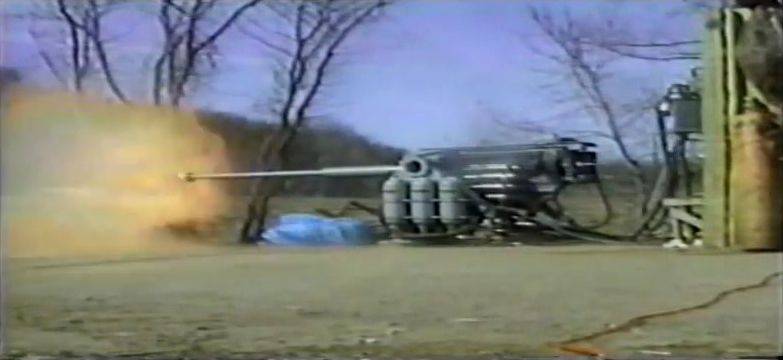
The first series of tests at the site. Used conventional shells
The remaining footage chronicles show that the experienced gun had no mechanisms designed to extract spent cartridges from the drum and reload. Perhaps such equipment could appear at a later stage of the project or in the development of a full-fledged combat system for ships. However, the prototype did not have the ability to self-recharge after using all the available ammunition.
The experimental ETK-gun received a combined propellant ignition apparatus, since during the tests it was proposed to use "ordinary" and electrothermochemical ammunition. A mechanical drummer was used to fire a conventional powder projectile; an electric igniter was used for ETX shots. According to others, the gun in all cases used an electric igniter.
As part of the 60 mm Rapid Fire ET Gun project, the issue of ammunition was actively explored. The gun could use traditional powder powder projectiles, in addition, some new versions of ammunition were developed. Research has been conducted on the subject of promising missile compositions, electrochemical ignition primers, etc. Also studied various options for the composition of the shells and the prospects of various materials of the liner. Offered cylindrical sleeve and bottle shape, made of metal or plastic with a metal tray.
The development of the perspective ETC-gun project was completed in 1991 year. At the beginning of the next year, the first tests started, during which the gun was mounted on a test bench and checked the operation of the main mechanisms. During this phase, the operation of the mechanisms was checked without the use of ammunition. The first stage of inspections made it possible to identify and eliminate some shortcomings, and also showed the efficiency of the proposed mechanisms. All this made it possible to proceed to field testing of the gun with real shooting.
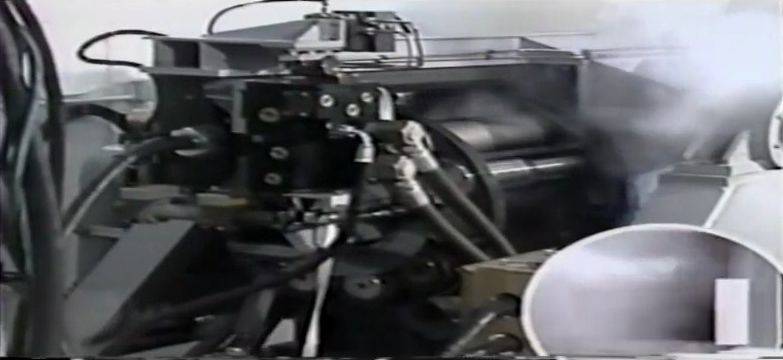
Breech of the gun when using ETH ammunition
Not later than March 1992, the 60 mm Rapid Fide ET Gun was delivered to the test site and installed on a stand of a simplified design. The stand allowed the pump to swing in a vertical plane and was equipped with recoil devices. Horizontal guidance was not provided, since there was no need for it. A similar device was used throughout the second test phase and soon gave way to a more advanced installation. The second phase of the test was carried out using "traditional" artillery shells. Information about the use of new ETH-shells are not available. The gun showed its capabilities, firing single and bursts. The length of the queues was limited by the capacity of the drum.
At the beginning of the summer of 1992, the first electrothermochemical projectiles, designed specifically for the promising weapon, appeared. Exact information about their design is not available, but it is known that they were equipped with the original ignition system and non-standard composition of the propellant charge. Later on, both “standard” and electrothermochemical projectiles were used in tests. Apparently, there were some problems with the finishing of shells, because of which their use had to be limited.
Around the end of the autumn of 1992, the assembly of an artillery installation was completed, which could be used on various warships. This device made it possible to direct a weapon in two planes and to bombard various targets on the shore, on the surface of the water and in the air. As well as the stand for field testing, the ship installation was equipped with recoil devices. In addition, apparently, it was the underdeck part of the artillery installation that had to be equipped with certain mechanisms for reloading the gun, but the details of this are unknown.
According to reports, the promising 60-mm ETX gun was tested before the 1992-93 winter. The gun fired in different modes using different ammunition. All this allowed us to collect the necessary information about the operation of the gun as a whole and its individual units. In addition, practical research was carried out on original projectiles using a non-standard method of igniting a propellant charge.
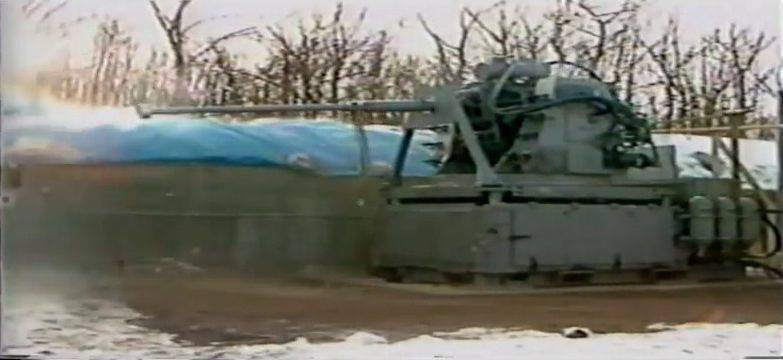
The gun on the ship's artillery installation, the last stage of testing
In the future, a new gun could become the weaponry of warships and solve the tasks of destroying surface targets or air defense. However, the 60 mm Rapid Fire ET Gun project did not leave the test stage. For various reasons, such weapons were not of interest to the military. Upon completion of the tests, the project was closed due to the lack of prospects. The gun and ammunition for it turned out to be too complicated and expensive for the full implementation and operation of navy. In addition, the fate of the project to a certain extent was affected by the change in the situation in the world associated with the collapse of the Soviet Union. Funding for promising projects has been reduced. A new electrothermochemical gun and many other developments fell under this reduction.
According to some sources, the reason for the closure of the project 60-mm ETH-gun was the rejection of another program. In the eighties, the mass of American organizations engaged in a large number of projects under the Strategic Defense Initiative. The 60 mm Rapid Fire ET Gun project also had some relevance to the PIO, although it was not directly related to missile defense or other strategic areas. The refusal of the PIO led to the closure of the mass of projects one way or another connected with this program. One of the “victims” of such a refusal was the project of a promising ship gun.
After completing the tests, the only experienced gun was probably sent to the warehouse of one of the organizations that participated in the project. Her fate is unknown. Nevertheless, it is known that this was not the last American project of naval artillery weapons, based on unusual ideas and solutions. In the future, US scientists engaged in the development of laser weapons and the so-called. rail guns. The latter in the foreseeable future may become a new weapon of warships. Electrothermochemical systems, in turn, have not gone beyond the design or testing stage.
On the materials of the sites:
http://liveleak.com/
http://powerlabs.org/
http://sa100.ru/
http://raigap.livejournal.com/
Information